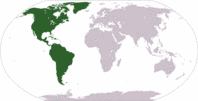Chamaedorea deckeriana
| Chamaedorea (kahm-eh-doh-REH-ah) deckeriana (deh-ker'-ee-ahn-ah) | |||||||
|---|---|---|---|---|---|---|---|
 | |||||||
| Scientific Classification | |||||||
| |||||||
| Synonyms | |||||||
|
| |||||||
| Native Continent | |||||||
|
| |||||||
| Morphology | |||||||
| |||||||
| Culture | |||||||
|
| |||||||
| Survivability index | |||||||
|
| |||||||
| Common names | |||||||
|
| |||||||
Contents
Habitat and Distribution
Chamaedorea deckeriana is found in COSTA RICA, and in a few parts of PANAMA in the wet forest on the Atlantic slope up to 900 m elevation.Description
Chamaedorea deckeriana is a particularly attractive plant, and with it's scarcity would be much sought after by collectors. The packed and heavily laden bright red-orange fruits add to its overall spectacular appearance. It is solitary with large coarse bifid leaves having an almost corrugated look, from .3- 2 m tall, with a slender stem of 2-3 cm in diameter. Editing by edric.
Uncommon in cultivation and easily confused with C. allenii and C. zamorae. It exists in a few collections in California, Florida, Hawaii, and Australia. It is also cultivated in a few gardens in Costa Rica.
Culture
Like most understory "Chams", it prefers a sheltered, and moist but well drained position. Will grow in tropical through to warm, temperate regions.
Comments and Curiosities
Hodel reports the flowers have a distinct pungent fragrance the permeates the greenhouse in where he is growing this species which "conjures up images of a deep, dark, primeval rain forest, just the sort of habitat in which one finds C. deckeriana."
Chamaedorea is a dioecious genus - meaning the male and female flowers occur on separate plants. The Greek is translated to mean “gift on the ground” - possibly referring to the small stature and pleasant surprise of finding such a gem at your feet.
The epithet honors 19th-century German botanist G. H. Decker, from whose garden the type originated.
- IMAGE GALLERY
External Links
References
Phonetic spelling of Latin names by edric.
Special thanks to Geoff Stein, (Palmbob) for his hundreds of photos.
Special thanks to Palmweb.org, Dr. John Dransfield, Dr. Bill Baker & team, for their volumes of information and photos.
Glossary of Palm Terms; Based on the glossary in Dransfield, J., N.W. Uhl, C.B. Asmussen-Lange, W.J. Baker, M.M. Harley & C.E. Lewis. 2008. Genera Palmarum - Evolution and Classification of the Palms. Royal Botanic Gardens, Kew. All images copyright of the artists and photographers (see images for credits).
Hodel, D.R.1992. Chamaedorea Palms, The Species and Their Cultivation. The International Palm Society.
Many Special Thanks to Ed Vaile for his long hours of tireless editing and numerous contributions.










